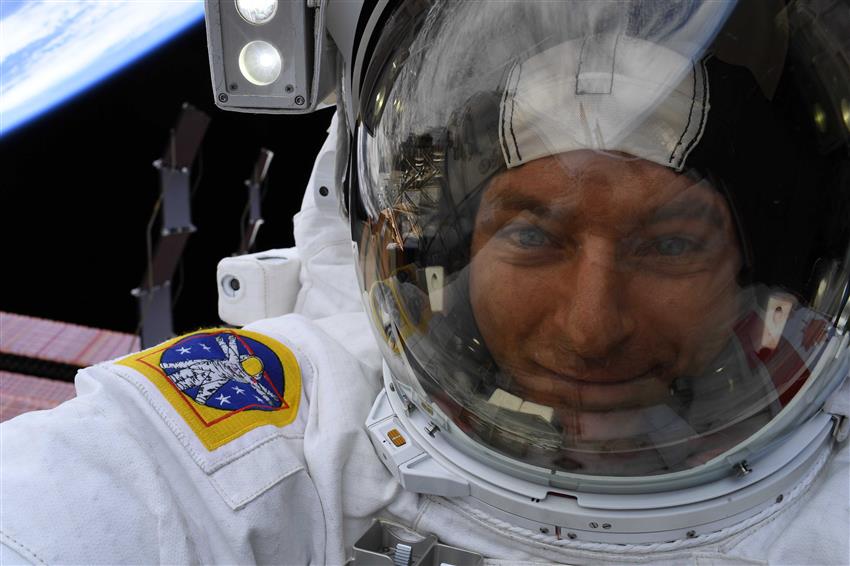These Boots are Made for Spacewalking
Background
When an astronaut performs a spacewalk outside the International Space Station (ISS), it is called an extravehicular activity, or EVA for short. EVAs are physically and mentally demanding and can sometimes last longer than eight hours. Astronauts must use their hands and arms to move along the handrails located on the exterior of the ISS. They must complete complex tasks such as replacing batteries and upgrading systems. On David Saint-Jacques' recent mission, he completed a six hour and 29 minute spacewalk. David and his colleague, NASA astronaut Anne McClain, relocated a battery adapter plate and upgraded the wireless communication system. They also connected electrical cables to establish an alternate path of power to Canadarm2. You can find out more about David's spacewalk here:
- David Saint-Jacques explains how a spacesuit works
- David Saint-Jacques' first spacewalk on the International Space Station
- Getting ready for a first spacewalk
Before going to space, astronauts prepare for EVAs in a large swimming pool called the Neutral Buoyancy Laboratory at NASA's Johnson Space Center in Houston, Texas. This is one of the reasons that astronauts must be good swimmers. You can find out more here:
EVAs are an essential part of maintaining the ISS. Astronauts performing an EVA must be physically fit because they have to exert themselves over a long period of time. They must also remain mentally alert to carry out their tasks. An EVA can be very challenging, but the view is out of this world!
Mission description
During this mission, participants will challenge themselves both physically and mentally. Astronaut crews of three will simulate moving around the outside of the ISS on a grid while completing dynamic physical exercises. When they reach their destination, they will complete several brain teaser puzzles (see participant handout) to simulate the complex challenge of fixing and upgrading systems on the ISS after physical exertion.
Timeline
| Description | Duration |
|---|---|
| Background | 5 minutes |
| View videos (optional) | 5 minutes |
| Activity explanation and demonstration | 10 minutes |
| Group activity | 20 minutes |
| Wrap-up | 5 minutes |
| Total | 45 minutes |
Goal
To complete a combination of physically and mentally demanding tasks to simulate an EVA.
Objectives
By the end of this mission, participants will be able to:
- Identify the purpose and challenges of an extravehicular activity
- Simulate the cardiovascular and muscular endurance required to move around the ISS
- Simulate the mental alertness required to complete complex mental tasks after physical exertion
- Work collaboratively as a team to accomplish a shared goal
Mission preparation (on land)
Materials
- Printouts of brain teasers (see participant handout)
- Pencils
- Tape, rope or other marker to show the path that participants must travel (alternatively, you can use lines on a gymnasium floor)
Set-up
- Use an area suitable for exercise.
- Designate one end of the play space as the starting line (which simulates the airlock on the ISS).
- Designate the other end of the play space for completing the brain teasers.
- If necessary, mark off the path that participants must follow from the starting line to the area where the puzzles are (below is a suggested layout, but activity can be adapted as needed).
- Provide pencils/pens for the brain teasers.
Mission instructions

Layout
- Participants organize themselves into astronaut crews of three.
- The crew must travel along the grid on the floor while performing a physically demanding exercise. (The exercise and the size and shape of the grid are left to the discretion of the activity facilitator. See PDF for suggestions.)
- When the crew reaches their pile of puzzles on the other side of the play space, they must complete one brain teaser in its entirety.
- Once the puzzle is complete, crews must verify their answers with the activity facilitator.
- If the puzzle is correct, the crew can head back to the starting line, again using the grid and performing a physically demanding exercise.
- Repeat steps 2 to 5 until all puzzles are completed correctly.
- After the third puzzle, crews must travel along the grid back to the starting line once more to complete their mission.
Mission preparation (pool)
Materials
- Printouts of brain teasers (see appendix)
- Pencils
- Ropes, cones or other markers (optional)
Set-up
- Use a large-lane swimming pool. Because pool configurations will be different, set up as a dynamic course where participants must reach designated spots.
-
Have participants move along an obstacle course to simulate moving on the outside of the ISS.
- Selection of activities to reach the destination are to be determined by the facilitator based on availability of materials and abilities of the participants. See appendix for suggestions.
- Designate one side of the pool as the starting line (which simulates the airlock on the ISS) and one area to place the puzzles.
- Provide towels at the end of the pool with the brain teasers so participants can dry off before working on them.
- Provide pencils/pens at the end of the pool with the brain teasers.
Mission instructions
- Participants organize themselves into astronaut crews of three.
- The crew must travel along the path designated by the activity facilitator.
- When crews reach their puzzles, they must exit the water and dry off.
- Crews complete one brain teaser in its entirety.
- Once the puzzle is complete, crews must verify their answers with the activity facilitator.
- If the puzzle is correct, the crew can get back in the pool and complete the course in reverse to the starting line.
- Repeat steps 2 to 6 until both puzzles are completed.
- After the second puzzle is complete, crews must travel along the course back to the starting line one last time to complete their mission.

